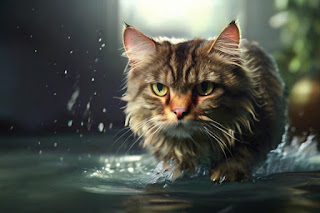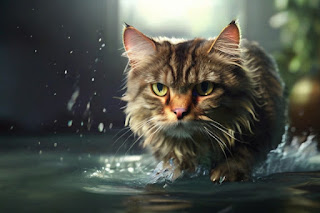Unlocking the Secrets of Cat Hydration: A Comprehensive Guide
Introduction
Proper hydration is a cornerstone of feline health, and understanding the intricacies of cat hydration is vital for responsible pet ownership. In this comprehensive guide, we’ll delve into the various aspects of cat hydration, from recognizing signs of dehydration to exploring creative strategies for encouraging water intake. Let’s embark on a journey to ensure that your feline friend stays well-hydrated and enjoys a healthy life.
1. Introduction to Cat Hydration
Cats, like humans, require an adequate intake of water for optimal health. Many cat owners may underestimate the importance of proper hydration, assuming that their feline companions can meet their water needs independently. However, understanding the unique hydration requirements of cats is crucial. We’ll dispel common myths and emphasize the significance of a proactive approach to cat hydration.
2. Signs of Cat Dehydration and How to Spot Them
Detecting dehydration in cats is not always straightforward, as felines are known for hiding signs of weakness or illness. This section will provide a detailed exploration of subtle indicators that may signal dehydration. By learning to recognize these signs early on, cat owners can take prompt action to address hydration issues and safeguard their pets’ well-being.
3. Health Issues Affecting Cat Water Intake
Various health conditions can impact a cat’s water consumption, ranging from dental issues to kidney problems. Understanding these factors is essential for cat owners seeking to address the root causes of reduced water intake. We’ll delve into the correlation between specific health issues and hydration, providing valuable insights for informed decision-making.
4. Encouraging Cat Hydration – Tips for Cat Owners
Practical advice for cat owners is essential in fostering a habit of regular water consumption in their feline companions. From choosing the right water bowl to incorporating hydration-friendly practices into the daily routine, this section offers actionable tips to ensure that your cat receives an adequate water supply, promoting overall health and well-being.
5. Cat Water Preferences and Choosing the Right Bowl
Cats can be discerning about their water sources, and the choice of a water bowl can significantly influence their preferences. In this segment, we’ll explore the diverse options available and discuss the factors to consider when selecting the most suitable water bowl for your cat. A happy cat is more likely to stay hydrated, and finding the right bowl plays a crucial role in achieving this.
6. Cat-Friendly Water Sources in the Home
Beyond traditional water bowls, there are alternative water sources within the home that can entice cats to drink more. By identifying and strategically placing these sources, cat owners can encourage their feline friends to explore and enjoy different ways of staying hydrated. This section aims to help integrate hydration into the cat’s environment seamlessly.
7. Cat Water Fountain Benefits and How to Choose One
Cat water fountains offer numerous benefits, from providing a constant flow of fresh water to satisfying a cat’s preference for moving water. Here, we’ll unravel the advantages of incorporating a water fountain into your cat’s environment. Additionally, we’ll provide a comprehensive guide on choosing the right fountain that aligns with your cat’s specific needs and preferences.
8. Wet Cat Food and Its Role in Hydration
Diet plays a significant role in a cat’s overall health, including hydration. Wet cat food, with its higher moisture content, can contribute to increased water intake. We’ll explore the connection between diet and hydration, offering practical tips for cat owners looking to enhance their feline companion’s water consumption through a balanced and nutritious diet.
9. Veterinarian Advice on Cat Hydration
Insights from veterinary professionals are invaluable for cat owners seeking expert guidance on hydration. In this section, we’ll share perspectives from veterinarians, addressing common concerns and questions related to cat hydration. This expert advice aims to empower cat owners with the knowledge needed to make informed decisions about their pets’ well-being.
10. Hydration and Urinary Health in Cats
The link between hydration and urinary health in cats is profound. Dehydration can contribute to urinary issues, emphasizing the critical role of proper hydration in preventing such conditions. This segment will provide a deeper understanding of this connection and offer actionable tips for maintaining optimal urinary health through effective hydration practices.
Frequently Asked Questions (FAQ) – Cat Hydration Guide
1. Why is cat hydration important?
Adequate hydration is crucial for various physiological functions in cats, including kidney function, digestion, and overall health. Proper hydration helps prevent urinary tract issues and ensures your cat’s well-being.
2. How can I tell if my cat is dehydrated?
Look for signs such as lethargy, sunken eyes, dry gums, and reduced skin elasticity. If you notice these symptoms, it’s essential to consult with a veterinarian promptly.
3. Are there health issues that can affect a cat’s water intake?
Yes, several health conditions, including kidney disease, diabetes, and dental problems, can impact a cat’s water consumption. Identifying and addressing these issues is crucial for maintaining hydration.
4. What are some creative ways to encourage my cat to drink more water?
Providing a cat-friendly water fountain, offering wet cat food, and strategically placing water bowls in different areas of your home are effective ways to entice your cat to drink more water.
5. How do I choose the right water bowl for my cat?
Consider your cat’s preferences, bowl material, and size. Some cats prefer shallow bowls, while others may prefer deeper ones. Stainless steel or ceramic bowls are often recommended.
6. What alternative water sources can I introduce in my home?
Consider placing water bowls in different locations, introducing cat-friendly water features like dripping faucets, or offering ice cubes for your cat to play with and lick.
7. What are the benefits of using a cat water fountain?
Cat water fountains provide a continuous flow of fresh water, which can be more appealing to cats. They also help prevent stagnation and encourage increased water intake.
8. How does wet cat food contribute to hydration?
Wet cat food has higher moisture content than dry food, contributing to your cat’s overall water intake. It’s an excellent option to promote hydration, especially in cats that may be reluctant to drink water.
9. Why is veterinary advice important for cat hydration?
Veterinarians can provide personalized guidance based on your cat’s health, age, and specific needs. Regular veterinary check-ups ensure early detection of any health issues that may impact hydration.
10. How can I maintain my cat’s urinary health through hydration?
Ensuring your cat stays adequately hydrated can help prevent urinary tract issues. Offering a balanced diet, promoting regular water intake, and monitoring your cat’s habits are essential for urinary health.
Conclusion
In conclusion, cat hydration is a multifaceted aspect of feline care that deserves careful consideration. By raising awareness, recognizing signs of dehydration, addressing health issues, and implementing practical strategies, cat owners can ensure that their feline companions lead healthy, happy lives. Remember, the key to unlocking the secrets of cat hydration lies in understanding your cat’s unique preferences and providing a supportive environment that promotes regular water intake. As you embark on this journey, your efforts to keep your cat well-hydrated will undoubtedly contribute to a long and fulfilling companionship.

